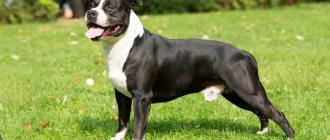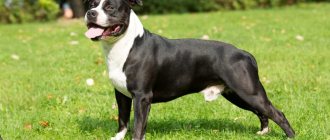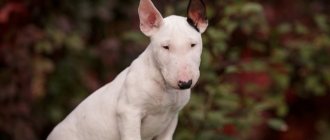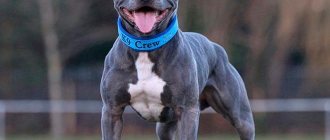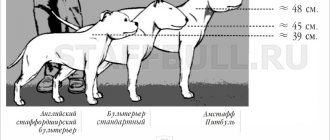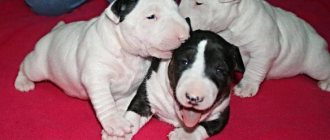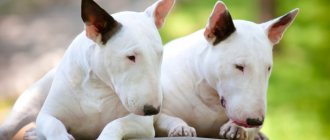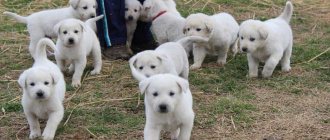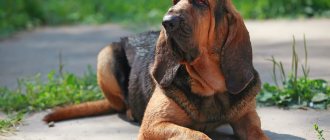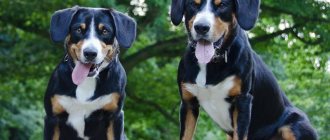- Pets
- >>
- Dog breeds
* Here is a photo of a typical representative of the Staffordshire Bull Terrier dog breed . You can send us photos of your animals by email, and we will post them on the website. Don't forget to send your pet's name.
Other breed names:
English Staffordshire Bull Terrier
Video
* We invite you to watch a video about the Staffordshire Bull Terrier . In fact, in front of you is a playlist in which you can select and watch any of 20 videos about a given dog breed by simply clicking on the button in the upper right corner of the window. In addition, the material contains quite a lot of photos. By looking at them you can find out what a Staffordshire Bull Terrier looks like.
In this article:
|
Rate the material!
[Total votes: 0 Average: 0]
The Staffordshire Bull Terrier looks like a stocky and powerful bull terrier. It’s immediately obvious that they have a lot of endurance and assertiveness. What is their inner mentality and character? What kind of habits do these canine athletes have? How did this breed appear and what are its characteristics? We will try to understand all these subtleties by describing the “staffie” from all sides.
Training
It is important for the Staffordshire Bull Terrier to learn obedience and socialization from the first days of being in the family. When you can walk with your puppy, he should immediately be taught to walk on a leash, including a short one. Over time, they become accustomed to a muzzle - a mandatory piece of equipment for a city dog.
From an early age, the bull terrier is accustomed to being in crowded places, riding in public transport, and visiting dog parks. Gradually, the dog gets used to noise, many smells and large crowds of people, and reacts calmly to everything. The sharp mind and energy of bull terriers can be used by training dogs to protect people and protect property, and rescue work. The animals pass the entire test course for service dogs with flying colors, with the exception of high jumps.
Experienced dog handlers do not recommend encouraging a Staffordshire Bull Terrier to become aggressive. There is a risk of getting an uncontrollable dog. As a bodyguard, it will be enough for the staff to growl threateningly; setting him on a person is risky.
History of the origin of Staffordshire bull terriers
The Staffordshire Bull Terrier is often called a Staffy Bull or Staffy. Dogs owe their origin not to any trends of the times or certain needs, but to the search for profit. In the first half of the 19th century, poor Englishmen found such entertainment as dog fighting, which began to gain not only popularity, but also generate income. The dogs fought for a reason, but for money in the form of bets. The presence of money stakes further interested the crowd in this brutal competition.
Initially, bulldogs took part in the fights, then they began to use various terriers. Gradually, fighting became commonplace and was no longer of much interest to the poor, so dog owners began to think about creating a dog color that would stir up unprecedented interest in fighting and enrich them.
Experiments began, during which bull and terriers appeared. They were the result of crossing bulldogs with English terriers. Such dogs fought more skillfully, were much more resourceful, more passionate and had lightning-fast high-speed reactions. In addition, the four-legged animals had an excellent mouse-catching ability, which is why a new show in the form of rat baiting became popular.
Further improvement and experimentation with the bull and terrier breed proceeded spontaneously; the breeders had no restrictions in this regard.
The result was the emergence of three types of staffies:
- The Warlaston type was distinguished by its small size, optimal fatness and short limbs, like a bulldog;
- The cradle type was compact, but strong, had a developed and powerful backbone;
- The Varsol type is more similar to terriers, distinguished by long legs and a lean figure.
Staffies acquired their current appearance, characteristic of modern dogs, closer to the second half of the 19th century. The breed standard was established only in 1935, when dog fighting became illegal. The standard for the appearance of these dogs was the Cradley type, in which stockiness and power were visible.
History of the breed
Several hundred years ago, cruel spectacles were popular in old England - large dogs baiting bulls and boars. Huge mastiffs, and later bulldogs, were used for hunting large animals and bloody entertainment for wealthy citizens. But these dogs, although they had remarkable strength, were not fast and dexterous enough. Then they began to be crossed with small and fast terriers, of which there were a lot in England. The result was a medium-sized, strong, agile and fast dog for spectacular fights - a bull terrier.
In the 19th century, bull terriers began to be exported to the New World, where owners continued to pit the dogs against each other, selecting for increased strength and aggression. In England, by this time, dog fighting was already banned; animal selection changed its focus on developing friendliness in the bull terrier. At the beginning of the 20th century (in 1939), the English Staffordshire Terrier breed was officially recognized. Dogs bred in the USA began to be called the American Staffordshire Terrier. This is how the separation of breeds occurred.
Staffordshire Bull Terrier - description of the breed
Staffordshire Bull Terriers can be called smooth-haired, stocky, big guys with a powerful chest and a highly intelligent gaze that monitors everything around. Outwardly, Staffies are similar to pit bulls, but they also have their own characteristics that are unique to this breed.
Interesting fact: Among the obvious differences, it is worth noting that the Staffie is smiling, which he owes to his developed cheek muscles and wide skull, and the dog is shorter in stature than a pit bull. The height of a Staffie at the withers can reach 40 cm, the weight of males varies from 17 to 20 kg, and females - about 15 kg.
The shape of the Staffie's skull is quite wide, but at the same time it is compact, the stop is clearly visible, and the muzzle itself is short compared to the entire head. The presence of powerful and developed jaws is immediately noticeable, because dogs have an outstanding grip. The bite should be full and correct. The tip of the dog's nose (lobe) is of medium size and rich black in color. Dog eyes that are round, straight and dark in color are considered ideal for a Staff Bull. But in life there are often dogs with a light iris color, which is in complete harmony with the coat color.
The staffbull's ears are shaped like a flower petal, are semi-erect and not very large. A unique feature of the dog is its neck, which looks quite dense and short, making the physique stocky, strong and squat. The whole figure of the Staffie is quite well-built, powerful, the dog's body is slightly elongated, has a perfectly straight back, a deep and solid chest, spreading out in width.
The front limbs of a dog are slender, have shoulder blades laid back, fairly powerful, strong wrists and paws that look outward. The hind legs are more muscular, with sloping shins and low hocks. The dog's tail is not particularly long; it is short, straight and set low.
Description
This is a strong, stocky animal with a broad chest and well-developed muscles. The height at the withers is 35-42 cm. The weight of males reaches 17.5 kg, females are 2-3 kg lighter. The dog's modest size is combined with exorbitant physical strength and poor sensitivity to pain. The Bull Terrier's head is large, square in shape, and its forehead is wide. The jaws are massive. The ears are erect, with drooping tips, and are often cropped short. The muscles of the neck and back are well developed. The tail is of medium length, set low, never curled.
The dog's coat is short and lies close to the body. The skin is thick and has no folds. Standard colors of the English Staffordshire Terrier:
- ginger;
- white;
- brindle;
- blue;
- pale yellow;
- black.
Sandy-gray and black with white spots are undesirable.
Popular colors of Staffordshire bull terriers
Staffbulls are classified as short-haired dogs; they have a fairly tough coat in tandem with rough animal skin, perfectly adapted to protect the body during fights and fights. These dogs do not have undercoat.
Popular (most typical) colors include:
- Amber;
- Reddish;
- Light dominant;
- Gray (blue);
- Black.
It is worth noting that a two-tone color combination is acceptable; previous markings in the color are not considered a fault. Let's try to describe in more detail some dog colors.
The red colors of Staffbulls are quite popular and are diverse, differing in some shades and range. For example, the sable color is considered to be a dog's fur coat, the main tone of the hairs of which is red, and the tips are dark.
Often dogs of this color have a kind of dark mask on their face. Many experts consider the gray (blue) color to be bleached black. Such four-legged animals often have lighter eyes and nose. The zone gray color includes dogs that have a solid gray coat, a black nose and dark eyes.
Interesting fact: Staffies also have brindle colors. It may have rare dark stripes against a general background of red or light color, but it happens the other way around - the black background is diluted with infrequent lighter streaks (stripes), this color is called dark motley.
As already noted, white spots are inherent in various colors of Staffbulls; they are not considered defects. Many dogs have rare (single) small white spots against a general monochromatic background. In other four-legged animals, on the contrary, very little dark color remains; it turns into separate spots, so the dogs look almost white. Undesirable colors of the Staffordshire Bull Terrier include tan (black and tan, brown and tan) or liver-colored coat.
Content
The Staffordshire Bull Terrier should be kept indoors: an apartment, a private house, since it is not very adapted to cold climates. Although the Staffbull is jumping and energetic, it will still take up little space due to its compact size. It’s a good idea to buy him a few rubber toys: he loves to bite and chew, and these devices will also come in handy in training.
This is a breed that can sometimes watch TV in the company of its owner, but will always prefer active entertainment to passive relaxation. Until one year, the puppy should not perform too intense physical exercise, games, running, or various sports competitions in which adult dogs can participate. You cannot walk under the direct scorching sun, since the staff’s thermoregulation is slowed down due to the short structure of the muzzle. In winter, puppies should walk no longer than 15-20 minutes.
Teenage Staffies and adult representatives of the breed must be walked on a leash, and in crowded places - with a muzzle. Stafforshires contain the genes of terriers who love to dig and rummage in the ground. Therefore, it is better for the dog to find a secluded corner or allocate a place in the garden where he can have fun without restrictions or damage to the landscape.
The dog tolerates frosts down to -15 degrees well; you can additionally buy overalls and special slippers that protect the paws from reagents. Due to short hair, the dog can freeze, for example, in the rain, so it is enough for him to wear a raincoat or sweater.
Character and habits of Staffordshire bull terriers
Many people mistakenly believe that Staffbulls are too aggressive and unfriendly, apparently due to their fighting history of origin. This is not entirely true. Today's dogs can be confidently called peaceful and quite friendly animals. Experts assure that Staffies are the most people-oriented dogs, although their appearance does not confirm this.
A well-mannered and balanced bull terrier has great respect for his owner and values friendship with him above all else; for him, communication with his beloved friend is the most precious reward. The four-legged dog is ready to act as an escort everywhere, so you need to understand that the staff’s attention will be constant.
Staffies do not experience great joy when they see other dogs or cats, but they are not particularly bloodthirsty towards them. Of course, running after an onlooker or teaching a dog a lesson is considered natural for them. It is possible to train a Staff Bull to live under the same roof with other pets, but this must be done diligently from the dog’s childhood.
Interesting fact: Staffordshire Bull Terriers are very friendly towards children, because... They are not considered rivals. They behave with children affectionately and prudently, trying to show care and attention. It is very interesting to watch the changing emotions of a staffie when he sees a child.
Even if a few minutes ago the dog was having a showdown with some other dog, when it sees a child, it immediately transforms and can begin to lie right on the territory of the playground, waiting for the little one to show attention and scratch the four-legged belly. Of course, you need to monitor such communication, because provocations from children can be sophisticated. But time shows that staff bulls do not enter into conflict with the inhabitants of sandboxes, showing restraint and friendliness.
A dog with a fighting history imposes certain obligations on its owner, primarily regarding training and socialization, which cannot be evaded, because an ignorant staff bull who does not know the commands is a threat to others. Yes, aggressiveness towards people and other animals in these dogs is reduced, but no one is talking about complete harmlessness. The best and optimal training program for Staffies is the General Training Course (GCC).
When training, you will have to show patience and endurance, the main thing is to assert your authority. Staffbulls are distinguished by stubbornness, a certain self-will, which results in them changing commands and acting at their own discretion. It is worth noting that putting pressure on dogs will not help matters, but will only make everything worse; staffies will not tolerate cruelty and rudeness.
Personality of the Staffordshire Terrier
Despite its formidable past and terrifying appearance, the English Bull Terrier is a friendly and cheerful animal. Breeders were able to defeat natural aggression in dogs towards their own kind, but it never existed towards people. Staffordshire Terriers are distinguished by their cheerful disposition, inexhaustible energy and mobility. This is an ideal companion for hiking, cycling, and noisy ball games.
A stable psyche, intelligence and flexibility make training a dog not difficult. The animal rarely barks, which is a big plus when kept in urban conditions. Loneliness is very difficult for staff. When left alone in an apartment for a long time, he may start acting out: chewing furniture, tearing clothes. This dog needs a lot of attention and communication.
Staffies are gentle with children and pets. The dog is well aware of its strength and shows caution when playing with weak people. However, you should not entrust your child with walking a bull terrier. In the event of an unforeseen situation, the baby will not be able to hold the powerful dog.
Interesting facts about Staffordshire Bull Terriers
There are different opinions about such an amazing and extraordinary dog breed as the Staff Bull, but there are a number of interesting facts that take place. They characterize the image of this four-legged person, describing her from various angles.
Let’s try to cite the most interesting ones, listing them point by point:
- The adjective “Staffordshire” was assigned to the bull terrier due to the fact that the breed appeared in the English county of Staffordshire in the 19th century;
- The Staffordshire Bull Terrier is often called a “nanny dog” because of its affectionate and friendly attitude towards children;
- The talent of a rat catcher is in the staffbulls' blood. The most famous in this regard was the dog Billy, who in 1823, in a five-minute period of time, strangled a hundred rats that were furiously attacking her;
- For decades now, Staffbulls have been the living mascots of the Prince of Wales's Staffordshire Regiment;
- In order to develop this particular breed, bulldogs were crossed with all kinds of terriers;
- Recognition of the breed standard occurred in 1974, since then bull terriers have been divided into American and English;
- Staffies have a high pain threshold, so they can endure even serious damage (injuries) very patiently;
- Staffy bulls cannot be overcooled or overheated, so these dogs are recommended to be kept in apartments;
- Staffies are real athletes, they can show class in such sports disciplines as: freestyle, frisbee, coursing and agility;
- The Staff Bull is a dynamic and active breed that prefers an accelerated rhythm of life with fun and active games and grueling runs to lying on the couch.
Breed standard requirements
Staffordshire Terrier breed is 100% natural. There must be dogs with uncropped ears at the show. Americans are allowed both natural and cropped ears.
In recent years, the first are preferred, which further brings together breeds from different continents. The main thing is that the ears do not hang completely. This is a tribal marriage. Uncropped ears should be partially erect, with only the tips hanging down.
The weight of English dogs is 11-17 kilograms. Height at the withers is from 35 to 41 centimeters. Americans weigh about 20 kilos and stretch up to 48 centimeters.
There are also differences in colors. Staffordshire Terrier dog comes in white, red, black, blue, brindle, and fawn colors. Light spots can be added to any of these colors.
For Amstaffs, white inclusions are not desirable. This is stated in the FCI standard. US cynological organizations generally consider the liver and black-and-tan colors of Staffordshire Terriers to be plembraces. Otherwise, the breed standards are the same.
American and English Staffordshires are muscular and inspire a feeling of power that is remarkable for their size. The dogs are stocky, with a wide and deep muzzle. There is a distinct line where the forehead and nose meet.
The latter, by the way, is of medium length, closer to shortened. The bridge of the nose is rounded with a black lobe, and below there is a wide and muscular jaw. Lips pressed tightly against hers. Droopy jowls would give the dog a relaxed appearance and would make fights with other dogs and animals risky. Loose lips are easily damaged in battles.
Both Stafford's ears and eyes are set wide apart. Pink eyelids are not acceptable. The shape of the eyes is round, and the iris is dark. Typically, Staffords are brown-eyed.
The Staffordshire Terrier's head should be set on a muscular neck of medium length. Towards the back of the head it narrows and is slightly curved. The neck is wide at the bottom and goes into strong shoulders. The shoulder blades are set obliquely on them.
The back of American and English Staffords is slightly sloping, smoothly turning into a tail, almost reaching the hocks. The latter of the representatives of the breed are parallel to each other. The main feature of the forelimbs is vertical pasterns. This is the name given to the bones of the feet, that is, the fingers.
The Staffordshire Terrier , brindle or other color, should spring when walking. The vice is ambling. This is the name for the movement when the paws go forward on one side, and both limbs go back on the other.
Due to their slightly lean belly and deep chest, Staffordshires look fit, even graceful with all their power. The bite is also harmonious. The upper canines meet the lower ones. Other options are marriage.
Pros and cons of Staffordshire Bull Terriers
Like any other breed, Staffies have their advantages and disadvantages, although owners consider their pets simply ideal. Let's try to look at staff bulls objectively and from the outside, describing all the pros and cons of keeping them.
Staffie advantages:
- Boundless love, respect and devotion to its owner are, of course, the undeniable dignity of a dog, but it is formed through careful training and training;
- Love for children can also be considered a plus, since these powerful four-legged animals are very kind to toddlers and take care of the kids, like real nannies;
- The compact dimensions testify in favor of the breed; such a dog is convenient to keep both in a large house and in a medium-sized apartment;
- Short hair is an important advantage, because it does not require special care, and there will be no tufts lying around;
- The dog is unpretentious in maintenance, which is a tangible advantage;
- Friendliness towards others is very important, especially with such a powerful and uncompromising canine species;
- Among the advantages include having courage and fearlessness.
Disadvantages of the breed:
- The main disadvantages include human opinion, which is often negative towards this dog due to its aggressive past. People react warily to Staffies, considering them dangerous. Although, if you remember, these four-legged creatures fought only with their own kind, without attacking humans;
- The requirement of training is a disadvantage for many owners, but for a Staff Bull, training is very important, because such a dog needs to be taught communication and obedience skills from childhood;
- Excessive energy can also be considered a disadvantage; you need to do a lot with a Staffie, developing not only his intelligence, but also his motor activity, and this should take a lot of time, because The dog needs long and dynamic walks;
- Stubbornness of character is also considered a disadvantage; because of this trait, many difficulties arise during training, so you should be patient.
Training and education
To make an English Staffbull a reliable protector and a loyal friend, you need to educate him. It is necessary to train a dog from the first days of its arrival in the house. This will show her who is in charge and who needs to be obeyed.
Walking with a bull terrier is one of the main methods of education
Training should be carried out from the age of one and a half months so that the puppy fully understands the commands. During education, the following nuances must be taken into account:
- The dog needs to be praised regularly. Praise not only makes Bull Terriers smile more often, but also encourages them to learn further.
- You need to regularly walk your dog in the fresh air. Walks are carried out to socialize the bull terrier.
- You should not yell at the dog or treat him too harshly. Dogs do not trust aggressive people, and will never consider them their leader.
Important! During training, you need to immediately eliminate your pet’s aggression so that in the future he will be calmer.
Breeding Staffordshire Bull Terriers
The mating of Staffbulls is not unusual; it is quite standard. Medium dimensions do not require a huge space or special conditions, but for the first mating it is better to call an experienced specialist in this matter who can help not only the dogs, but also their owners.
Staffies become sexually mature closer to ten months of age, but it is better to breed starting from 20 or 25 months, then the dogs are ready not only to conceive, but also to bear strong offspring. The most favorable period is considered to be the days from 13 to 15 from the time the third estrus began. The female these days can be either in a playful mood or slightly aggressive.
If the dogs are breeding dogs, have a pedigree, then mating must be done through a kennel; this requires filling out a special form and obtaining a certain certificate. Owners must agree in advance on the amount and time, which are usually set by the owner of the dog. Most often, it is a percentage of the price of the entire litter or is equal to the cost of one puppy.
Interesting fact: Dogs are introduced while walking together, this takes no more than 20 minutes. Then the female is taken into the dog’s possession so that he feels confident. Many owners believe that a male dog accustomed to domestic intercourse will not look for a passion on the side.
The female allows mounting if she is satisfied with everything; during intercourse, which lasts about 15 minutes, it is recommended to hold the bitch by the head. Repeated mating is carried out a couple of days after the first one. Most often, there are from 6 to 8 puppies in a litter, and the canine life expectancy of Staffbulls is 14 years.
Behavior and temperament
Positive traits:
- Balance and calm character;
- People orientation: love, sociability, desire to please, follow commands;
- Devotion;
- Love for children;
- Smartness. Ability to quickly learn new things;
- Security skills.
Negative features:
- Dependence on human attention: without socialization, dogs become aggressive;
- Stubbornness;
- Tendency to dominate among individuals of the same sex.
Caring for Staffordshire Bull Terriers
Short-haired bull terriers do not require special care for their fur coat; they can be brushed during shedding periods (spring and autumn). There is no constant need for this procedure; it rather acts as a stimulating massage. Water procedures should be carried out monthly, but only once. The Staffie should be washed with a diluted shampoo designed specifically for dogs with short hair. Dry your pet by simply blotting the towel; you can comb your pet using a rubber mitten.
Important fact: It is prohibited to take a staff bull outside when it is not dry, it is dangerous for him. In winter, the four-legged dog can be washed less often, once every 2 or 3 months.
It is imperative to inspect the dog’s ears and eyes, rinsing them with a moistened cotton pad to remove dust and accumulated wax. Watery eyes and an unpleasant smell from the ears indicate a health problem, so it is better to consult a veterinarian. The most common and burdensome procedure that a staffie needs to perform is toothbrushing. It is carried out with a brush and a special paste (powder) about four times per week.
It is also necessary to trim your bull's claws. When it’s warm, the claws are worn down from constant walking, so they need to be trimmed a little or polished with a file. In winter, haircuts are done quite often, before immersing the claws in warm water for steaming so that they soften a little.
Physical activity and constant activity are the most important life attributes of Staffbulls, but everything needs moderation. Puppies up to one year of age are not overloaded with strong training. Only older and mature dogs are offered entertainment such as chasing a cyclist, playing tug, Frisbee, etc.
You should beware of walking in intense heat, when the sun is mercilessly scorching. This breed is also afraid of severe frosts, but it reacts calmly down to minus 15 degrees, although warm overalls and special shoes will not hurt. It has been noted that males require more time for walks than females. Of course, for a successful and healthy life for pets, one should not forget about timely vaccinations and deworming measures.
Maintenance and care
Daily walks are required, at least 2 hours a day. The owner must actively play with the dog, enrich the environment with new toys, commands, and exercises.
It tolerates frosts calmly, as the dog moves a lot. It can withstand the heat normally, but you should not exhaust the animal by training under the scorching sun.
The drinking regime should be observed all year round.
Feeding
When choosing industrial food, it is better to give preference to premium and super-premium class. These foods are safe for health and carefully balanced.
A natural diet should contain: 70% meat, 10% offal. You should also include grains. Porridge: buckwheat, rice, pearl barley, barley. For proper metabolism, the menu includes vegetables: carrots, broccoli, zucchini, pumpkin.
Important! You cannot overfeed your dog. Obesity leads to serious health problems for your pet. The daily norm is divided into two meals.
Care of fur, claws, eyes
- Shedding is moderate as the coat is short and smooth. It is convenient to comb the Staffie's coat with a brush-glove.
- Claws are trimmed as they grow, 2 times a month.
- For preventive purposes, wipe the eyes
- Oral care requires attention, as tartar . You can clean them both at home with specialized brushes and in the veterinarian’s office.
Diet of Staffordshire Bull Terriers
Despite the fact that staffies are not large in size, they love to eat. They need this to replenish energy after walks and training sessions. For mature dogs, 500 to 700 grams of ready-made food, diluted with water, should be enough per day. Portion parameters are related to the dog’s activity, its weight and age, as well as the time of year, because in winter the need for food increases.
Puppies up to three months of age eat 5 or 6 times a day. Up to 6 months they are fed 3 or 4 times a day, and then they are transferred to twice a day feeding. When teething and changing teeth, dogs need to be given solid food, preferably in fairly large pieces. Naturally, each owner makes a choice between dry food and home-cooked food. The first option is more lightweight. But you should be careful when choosing a brand of food, having learned everything about its composition and balance.
Choosing a natural diet is more burdensome, but no less (and maybe more) beneficial. When the owner is involved in the process of preparing and buying food for the dog, he knows everything about its composition and quality, which is important.
The menu should consist of:
- Meat (beef, chicken, rabbit and lamb);
- Fish (sea, boiled and with selected bones);
- Eggs (a couple of times a week);
- Fermented milk products;
- Cereals (buckwheat, rice, oatmeal);
- Fruits and vegetables.
Fatty, salty and fried foods should be excluded; smoked, sweets and flour foods should also not be eaten. These dogs should not be given bones; they should be kept away from pork, potatoes, citrus fruits, grapes, melons, butter and legumes. Maintaining a drinking regime is considered important, so you need to make sure that there is always water in the bowl, and take bottles of water for walks in the summer.
Care
A short-haired pet does not require special care. It is enough to comb the fur during shedding, which occurs in spring or autumn, but this does not need to be done systematically. This procedure is more like a massage, since the appearance practically does not change after combing. The furs fit tightly to each other, so the staff looks neat regardless of the season.
There should be optimal humidity in the room: living in dry and warm apartments, Staffbulls shed all year round.
Diseases and health problems
Staffordshire Bull Terriers are mentally stable and physically strong enough. The genetics of this breed are strong, hardy, they are not sensitive to pain, but this can also play a bad joke when the disease is detected in the very last stages. Young puppies can pick up all sorts of infections, especially before they reach one year of age, so vaccinations play a very important role here. They do not provide a complete guarantee that the pet will not catch the infection, but it will be easier for a vaccinated dog to overcome it.
Staff bulls have the following types of diseases:
- Dysplasia of the hip and elbow joints, this disease is hereditary, resulting from excessive physical activity, is expressed by the presence of acute pain, limping, deformed paws, and is considered incurable;
- Brachycephaly, which is expressed by problems with the respiratory system, can occur with varying degrees of severity;
- Epilepsy;
- Deafness;
- Cataracts;
- Frequent bloating;
- Urolithiasis;
- Tendency to volvulus;
- Food allergic reactions.
Many high-quality kennels screen dogs for the presence of dysplasia and patella, which leads to the exclusion of affected animals from participation in the breeding process. Tests that detect cataracts and epilepsy are considered desirable, because No effective treatments for these diseases have yet been found. It should be added that it is important to take care of the pet, constantly examine it, and monitor its behavior and mood. If the owner notices any deviations in time, then serious negative consequences, in most cases, can be avoided.
Health
With proper care, Staffordshire Bull Terriers can live for about 10-16 years. The owner must regularly show the pet for preventive examinations to specialists at the veterinary clinic. It is also important to carry out vaccination and treatment against parasites in a timely manner.
These dogs do not have any special health problems; by nature they are endowed with strong immunity and a strong body. But there is a predisposition to certain diseases:
• Digestive problems - bloating, volvulus, diarrhea. Most often they occur from poor nutrition and poor quality food. Diarrhea may be a symptom of infection. • Urolithiasis – stones form in the urinary tract. They can be located in the urinary tract, kidneys, ureter or bladder, but in most cases they are found in the bladder. • Mast cell cancer – Mast cell tumor is one of the most common skin tumors in dogs. • Hip dysplasia – underdevelopment of the acetabulum, leading to impaired musculoskeletal function of the limb. • Cataract – clouding of the crystal, which, if left untreated, can lead to complete loss of vision. • Entropion – entropion of the eyelid cannot be treated and can only be treated surgically. • Arthritis – accompanied by lameness, severe pain, and stiffness of movement. • Hyperadrenocorticism is a clinical syndrome that develops when there is an excess of corticosteroids in the body.
Peculiarities
The dog should live with the family, not in the yard. Walking is only allowed on a leash, as the breed is not friendly with other animals. Stubbornness can be traced in his character, many commands are carried out in his own way. The dog loves to relax with the owner on the sofa - the staff is an affectionate friend, but you should not accustom him to this. To raise a friendly dog, early socialization is required.
To avoid problems with teeth, buy hard toys for puppies and give them the opportunity to dig during walks. The breed is characterized by poor heat tolerance - overheating is possible, so it is better to postpone walks to the evening. Dogs have a high pain threshold - it is important to monitor your pet’s well-being and behavior. This breed is not suitable for home defense: the bull terrier is friendly, he does not worry about the boundaries of his territory.
